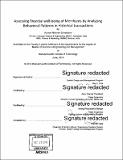| dc.contributor.advisor | Alex 'Sandy' Pentland and Irving Wladawsky-Berger. | en_US |
| dc.contributor.author | Srivastava, Kumar Abhinav | en_US |
| dc.contributor.other | Massachusetts Institute of Technology. Engineering Systems Division. | en_US |
| dc.date.accessioned | 2017-03-10T15:06:29Z | |
| dc.date.available | 2017-03-10T15:06:29Z | |
| dc.date.copyright | 2014 | en_US |
| dc.date.issued | 2014 | en_US |
| dc.identifier.uri | http://hdl.handle.net/1721.1/107348 | |
| dc.description | Thesis: S.M. in Engineering and Management, Massachusetts Institute of Technology, School of Engineering, Institute for Data, Systems, and Society, System Design and Management Program, 2014. | en_US |
| dc.description | Cataloged from PDF version of thesis. | en_US |
| dc.description | Includes bibliographical references (page 31). | en_US |
| dc.description.abstract | This study focuses on new approach to estimate financial wellbeing indicators for merchants, by looking at behavioral patterns of their customers in historical transactions. The transaction data for about 10,000 merchants in a specific country, was analyzed in terms of their diversity and propensity of customers for factors like age, distance they travel to shop, time of the day, day of the week, educational status, gender etc. While diversity refers to the variety in the different groups, propensity refers to concentration of customers in specific groups. These factors were used as independent variables to predict the financial well-being of merchants, particularly in two dimensions -total revenue and consistency in revenue, both relative to other merchants in the same industry. The merchants were also divided into the categories of Essential, Nonessential and Luxury goods depending on the industry they belong to and it was interesting to observe the contrast across categories. While the individual correlations were weak but significant, feature selection and classification (using logistic regression) indicate that diversity and propensity for factors of 'Age', 'Time of the day' and 'Day of the week' show reasonable prediction capabilities for total revenue and consistency in revenue for a merchant, as compared to the industry average. These kind of inputs can be very useful from a bank's perspective if an existing business customer of a bank wants to apply for a loan and the bank needs to assess the application. The analysis can be a good augmentation to the current methods or models of determining the financial wellbeing of a merchant. Also, this kind of analysis can bring a fresh perspective to the merchants to look at the customer base and then to target the right customers for achieving the business objectives of above average and consistent revenue streams. | en_US |
| dc.description.statementofresponsibility | by Kumar Abhinav Srivastava. | en_US |
| dc.format.extent | 31 pages | en_US |
| dc.language.iso | eng | en_US |
| dc.publisher | Massachusetts Institute of Technology | en_US |
| dc.rights | MIT theses are protected by copyright. They may be viewed, downloaded, or printed from this source but further reproduction or distribution in any format is prohibited without written permission. | en_US |
| dc.rights.uri | http://dspace.mit.edu/handle/1721.1/7582 | en_US |
| dc.subject | Institute for Data, Systems, and Society. | en_US |
| dc.subject | System Design and Management Program. | en_US |
| dc.subject | Engineering Systems Division. | en_US |
| dc.title | Assessing financial well-being of merchants by analyzing behavioral patterns in historical transactions | en_US |
| dc.type | Thesis | en_US |
| dc.description.degree | S.M. in Engineering and Management | en_US |
| dc.contributor.department | System Design and Management Program. | en_US |
| dc.contributor.department | Massachusetts Institute of Technology. Engineering Systems Division | |
| dc.contributor.department | Massachusetts Institute of Technology. Institute for Data, Systems, and Society | |
| dc.identifier.oclc | 973017990 | en_US |
